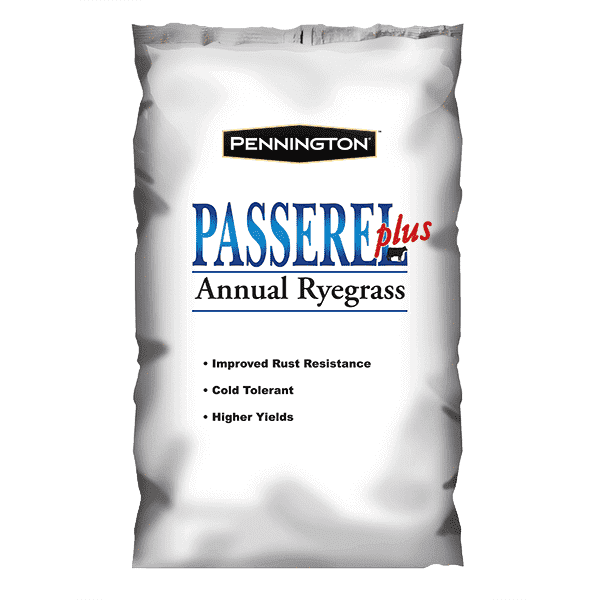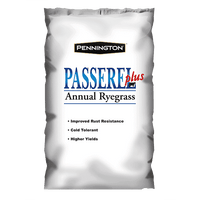
- When to plant:
- Fall, Winter
- Fertilizer:
- Hancock's 16-04-08 Lawn & Pasture Fertilizer
- Seeding rate:
- 30 - 35lbs. per acre
- Seeding rate drilling:
- 20 - 25 lbs. per acre
- Seeding depth:
- 1/8 - 1/4 inch
- Ideal ph:
- 6.0 - 7.0
- Gmo:
- No
- Inoculant needed:
- No
- Coated or raw:
- Raw
- Lifecycle:
- Annual
- Climate zones:
- Cool Season, Transition Zone, Warm Season
Passerel Plus Ryegrass Seed is great for overseeding warm season grasses for winter forage. This grass has good late fall growth and excellent spring growth.
Product Information
- Application or Use: Cattle Forage, Livestock Grazing, Cover Crop, Erosion Control
- Germination Time: 5 - 7 days, under optimal conditions
- Growing Locations: Warm Season, Transition Zone, Cool Season
- Height: 8 - 20 inches
- Sunlight Requirements: 4+ hours, full sun for best results
- Advantages: Good late fall growth and excellent spring growth; perfect for overseeding warm season grasses for winter forage.
- When to Plant: Recommended planting time is fall and winter when nighttime temperatures are consistently below 65 degrees.
Product Detail
- Grazing forage
- Hay
- Fast germination
- Thrives on well drained soils
- High yields
Product Information
This grass is mainly for a grazing forage for light rotational grazing starting in fall, with heavier rotational or continuous grazing in the spring. Never graze closer than 3 inches. This grass can be cut for high quality hay and also sod-seeded into warm season perennial pastures for winter and spring forage production.
It has good late fall growth, and excellent spring growth. Under good soil moisture and favorable weather, conditions will germinate in 7 to 10 days, and produce high quality forage for growing cattle (ADG of over 2 lbs). It out-yields the leading Ryegrass varieties in Southern Forage Yield Trials. Passerel Plus delivers grazing after other varieties are long gone.
It offers 15% crude protein, 60% total digestible nutrients. Nutritional quality can be affected by environmental conditions and management practices.
From Eastern Texas and Oklahoma, across the South to the Atlantic coast. It tolerates poorly-drained soils of the lower South. It thrives on well-drained soils with good water holding capacity. It is cold tolerant for Mid-South.
Ryegrass is a cool season variety, plant once nighttime temperatures are consistently 65 degrees and below.
*Product packaging may appear different than what is pictured.
Passerel Plus Ryegrass seed should be planted in the fall for winter grazing for cattle, sheep, and other livestock. Light rotational grazing in fall and winter, with heavier rotational or continuous grazing in the spring or early summer. Planted in early September to mid October with favorable weather conditions, Passerel Rye Grass will germinate in 7 to 10 days.
Plant at a rate of 20 to 25 lbs. drilled, or 30 to 35 lbs. broadcast. Plant from early September to mid-October. Plant into a well-prepared, firm seedbed, or it can be sod-seeded into closely clipped or grazed warm season perennial pastures. The key is a firm seedbed, and never to plant deeper than 1/2 in. deep. Lime soil to 6.0 pH, and follow soil test for nitrogen, phosphorus and potassium.
Allow light rotational grazing in the fall and winter, with heavier rotational or continuous grazing in the spring and early summer. Never graze closer than 3 in.
Ryegrass is a cool season variety, plant once nighttime temperatures are consistently 65 degrees and below.
When choosing to start a new lawn, remove old vegetation by using a de-thatcher, power rake or tiller to kill the existing vegetation. Rake or drag the area to remove debris and dead grass for a clean area. Ensure the soil is leveled and loosened to allow the seed to have good soil contact once spread on a clean seed bed.
If you have an area with heavy weed coverage, we recommend starting fresh by killing and removing the existing vegetation. If you choose to use chemicals, herbicides or fertilizers, you must check with the product's manufacturer prior to planting new seed to ensure the proper waiting period.
When overseeding an existing area, mow your lawn at the lowest setting and bag the clippingsx. Rake or drag any areas that have dead thatch or debris.

Seed Quality
Hancock Seed is dedicated to delivering the best seeds possible to our customers. Hancock Seed grows and harvests many of our products, and we acquire the majority of the rest from other family farmers.
All these seeds are processed, packaged and shipped from Hancock Farm. This helps us ensure that our high standards are met. Unlike much of the competition, we refuse to sell you a seed that was not gathered during the last harvest. You will always receive fresh product from Hancock.
Every seed we grow comes with 40 years of experience behind it...you can rest assured that all of our products are cultivated in a method that assures its potential for growth.

Your cart ( 0 )

Passerel Plus Ryegrass Seed is great for overseeding warm season grasses for winter forage. This grass has good late fall growth and excellent spring growth.
Product Information
- Application or Use: Cattle Forage, Livestock Grazing, Cover Crop, Erosion Control
- Germination Time: 5 - 7 days, under optimal conditions
- Growing Locations: Warm Season, Transition Zone, Cool Season
- Height: 8 - 20 inches
- Sunlight Requirements: 4+ hours, full sun for best results
- Advantages: Good late fall growth and excellent spring growth; perfect for overseeding warm season grasses for winter forage.
- When to Plant: Recommended planting time is fall and winter when nighttime temperatures are consistently below 65 degrees.
Product Detail
- Grazing forage
- Hay
- Fast germination
- Thrives on well drained soils
- High yields
Product Information
This grass is mainly for a grazing forage for light rotational grazing starting in fall, with heavier rotational or continuous grazing in the spring. Never graze closer than 3 inches. This grass can be cut for high quality hay and also sod-seeded into warm season perennial pastures for winter and spring forage production.
It has good late fall growth, and excellent spring growth. Under good soil moisture and favorable weather, conditions will germinate in 7 to 10 days, and produce high quality forage for growing cattle (ADG of over 2 lbs). It out-yields the leading Ryegrass varieties in Southern Forage Yield Trials. Passerel Plus delivers grazing after other varieties are long gone.
It offers 15% crude protein, 60% total digestible nutrients. Nutritional quality can be affected by environmental conditions and management practices.
From Eastern Texas and Oklahoma, across the South to the Atlantic coast. It tolerates poorly-drained soils of the lower South. It thrives on well-drained soils with good water holding capacity. It is cold tolerant for Mid-South.
Ryegrass is a cool season variety, plant once nighttime temperatures are consistently 65 degrees and below.
*Product packaging may appear different than what is pictured.
Passerel Plus Ryegrass seed should be planted in the fall for winter grazing for cattle, sheep, and other livestock. Light rotational grazing in fall and winter, with heavier rotational or continuous grazing in the spring or early summer. Planted in early September to mid October with favorable weather conditions, Passerel Rye Grass will germinate in 7 to 10 days.
Plant at a rate of 20 to 25 lbs. drilled, or 30 to 35 lbs. broadcast. Plant from early September to mid-October. Plant into a well-prepared, firm seedbed, or it can be sod-seeded into closely clipped or grazed warm season perennial pastures. The key is a firm seedbed, and never to plant deeper than 1/2 in. deep. Lime soil to 6.0 pH, and follow soil test for nitrogen, phosphorus and potassium.
Allow light rotational grazing in the fall and winter, with heavier rotational or continuous grazing in the spring and early summer. Never graze closer than 3 in.
Ryegrass is a cool season variety, plant once nighttime temperatures are consistently 65 degrees and below.
Instructions
When choosing to start a new lawn, remove old vegetation by using a de-thatcher, power rake or tiller to kill the existing vegetation. Rake or drag the area to remove debris and dead grass for a clean area. Ensure the soil is leveled and loosened to allow the seed to have good soil contact once spread on a clean seed bed.
If you have an area with heavy weed coverage, we recommend starting fresh by killing and removing the existing vegetation. If you choose to use chemicals, herbicides or fertilizers, you must check with the product's manufacturer prior to planting new seed to ensure the proper waiting period.
When overseeding an existing area, mow your lawn at the lowest setting and bag the clippingsx. Rake or drag any areas that have dead thatch or debris.


















